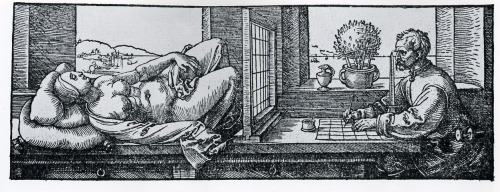The illustration Artist and Model in the Studio by Albrecht Dürer, first published in The Painter’s Manual in 1525, is a woodcut that has been readily used to illustrate the dominance of the male gaze in Western visual culture, as well as the general consequences of mechanizing the relationship between the viewer and the viewed. In 1993 French photographic artist Dany Leriche appropriated Dürer’s original image as Hanneke et Elise [1], interpretable as a feminist-inspired rejection of the male gaze. The image is part of a diptych – the second part is a photograph of the model taken through the grid from the point of view of the observer.
Previous appropriations at Jahsonic included Balthus’s The Guitar Lesson [1] by Japanese photographer Naoto Kawahara in 2007 [2].
Tip of the hat to Lemateurdart.
Previous entries in Icons of Erotic Art here, and in a Wiki format here.


Is Leriche’s piece any more than clever and amusing? I can’t even see this image as erotic. It was in a manual. Certainly an instance of the “male gaze”, but so..? Is the female gaze somehow superior?
I don’t see much appeal in art that requires you to read a manifesto to fully ‘get’ it.
I like clever and amusing, and I find the Leriche update most erotic, although I will not use it as a stroke picture, that dubious honor goes to real pornography, such as the one pastiched in Icons of erotic art #5, the most popular entry in this series. The pornography/erotic art dichotomy appears to be total in this respect.
I totally understand your remarks about the male gaze and the question about the female gaze, but nevertheless, I was very much intrigued by the concept when I found it in Laura Mulvey’s essays in my early days on the net. For the entry at my wiki I am attempting to split the gaze into male and female.
There is something I read about the gaze of which I can’t trace the roots nor pinpoint in time, but the argument goes like this: a woman always looks at herself through the eyes of a man, while the male gaze is independent of a “medium.”
About the manifesto thing: I follow you, and I don’t think you need a manifesto to appreciate Leriche’s pastiche. Nevertheless – again a nevertheless – I also appreciate a work that requires you to read a manifesto beforehand. It’s not an either/or but an and/and thing to me.
For example, some people make art – an art that can only exist in a museum – that attempts to leave no trace whatever of itself. People are hired in a museum to perform a piece, no recording is made, nothing is left behind, I think it was Yves Klein (by selling intangible stuff, and later the contract was burnt) who started something like this. This kind of art is extremely hermeneutic, esoteric and intellectual, but can capture my imagination.
As you can see from these rambling notes, I clearly have not the answer, nor a real position on these matters, I just want to stress the “what-is-ness” of things and perhaps also say: “you can’t argue with popular” and add: it is never either/or but always the multitude, the and/and thing.
Pingback: About the male and female gaze « Jahsonic
I didn’t mean to denigrate the piece. It IS clever and amusing. I just get my back up when I hear the clang and shriek of critical apparatus moving into gear.
I see what you mean and I totally agree.
Take for example Mary Ann Doane commenting on Un regard oblique
The vocabulary is awful: masculinization, spectorial, scopophilic (instead of voyeuristic). Yek.
Jan